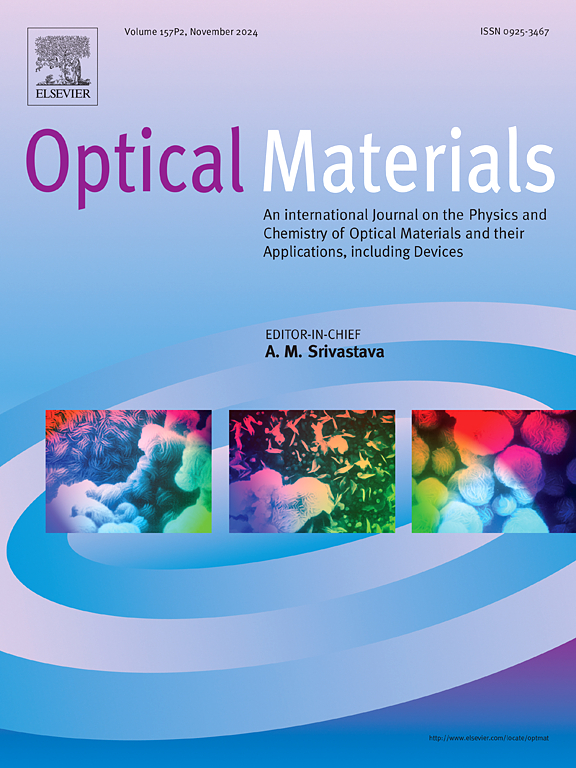The structure and optical properties of CdS films prepared by sulfur-atmosphere annealing of precursors
IF 3.8
3区 材料科学
Q2 MATERIALS SCIENCE, MULTIDISCIPLINARY
引用次数: 0
Abstract
High-quality CdS thin films were successfully fabricated using the sputtering-evaporation-sputtering method in conjunction with annealing in sulfur-vapor atmosphere. The structure, morphology, composition, optical properties and defects of the films were investigated by X-ray diffraction, scanning electron microscope, atomic force microscopy, UV–Vis spectrophotometer, and Slow Positron Doppler Broadening Spectroscopy. The results show that precursors include Cd and CdS and are converted into CdS films during annealing. The CdS films exhibit a hexagonal structure with oriented growth along the (002) crystal plane. And the CdS films have a dense structure without any cracks or pinholes and their S/Cd atomic ratios are in the range of 0.98–1.07. All CdS films have high transmittance in the visible range and band gap in the range of 2.38–2.41eV. Sulfur-atmosphere annealing improves the crystallinity, optical transmittance, and chemical composition of the CdS films. Besides, as annealing temperature increases, the crystallite size of the CdS films enhances with the rms surface roughness of 5.18–7.9 nm. It is also found that defect concentration in the annealed films decreases with increasing depth from the surface. And increasing annealing temperature is beneficial to improve the crystallinity of CdS films, attributed to the sulfur diffusion and occupation of sulfur vacancies. The CdS film annealed at 500 °C shows the good crystallinity, high uniformity, and low defect concentration, which can be utilized for photodetectors.
前驱体硫-气氛退火制备的CdS薄膜的结构和光学性能
采用溅射-蒸发-溅射相结合的方法,在硫蒸气气氛中成功制备了高质量的CdS薄膜。采用x射线衍射、扫描电子显微镜、原子力显微镜、紫外可见分光光度计、慢正电子多普勒展宽光谱等研究了薄膜的结构、形貌、组成、光学性能和缺陷。结果表明,前驱体包括Cd和Cd,并在退火过程中转化为Cd薄膜。CdS薄膜呈六边形结构,沿(002)晶面定向生长。CdS薄膜结构致密,无裂纹、无针孔,S/Cd原子比在0.98 ~ 1.07之间。所有CdS薄膜在可见光范围内具有较高的透过率,带隙在2.38 ~ 2.41 ev范围内。硫气氛退火改善了CdS薄膜的结晶度、透光率和化学成分。此外,随着退火温度的升高,CdS薄膜的晶粒尺寸增大,表面粗糙度rms为5.18 ~ 7.9 nm。退火膜中的缺陷浓度随距表面深度的增加而降低。提高退火温度有利于提高CdS薄膜的结晶度,这主要是由于硫的扩散和硫空位的占据。经500℃退火后的CdS薄膜结晶度好,均匀性高,缺陷浓度低,可用于光电探测器。
本文章由计算机程序翻译,如有差异,请以英文原文为准。
求助全文
约1分钟内获得全文
求助全文
来源期刊

Optical Materials
工程技术-材料科学:综合
CiteScore
6.60
自引率
12.80%
发文量
1265
审稿时长
38 days
期刊介绍:
Optical Materials has an open access mirror journal Optical Materials: X, sharing the same aims and scope, editorial team, submission system and rigorous peer review.
The purpose of Optical Materials is to provide a means of communication and technology transfer between researchers who are interested in materials for potential device applications. The journal publishes original papers and review articles on the design, synthesis, characterisation and applications of optical materials.
OPTICAL MATERIALS focuses on:
• Optical Properties of Material Systems;
• The Materials Aspects of Optical Phenomena;
• The Materials Aspects of Devices and Applications.
Authors can submit separate research elements describing their data to Data in Brief and methods to Methods X.
 求助内容:
求助内容: 应助结果提醒方式:
应助结果提醒方式:


